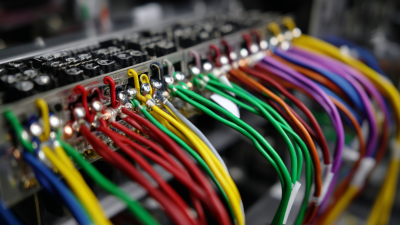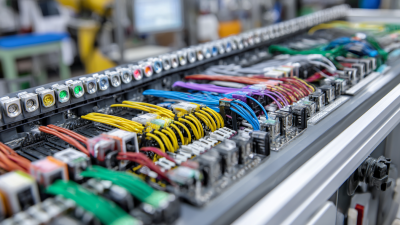What You Need to Know About SMA Male Connectors for Your Next Project
As the demand for high-frequency connectivity solutions continues to rise, understanding the intricacies of SMA male connectors becomes essential for engineers and project managers alike. According to a report by Markets and Markets, the RF connector market is projected to reach $2.89 billion by 2025, driven primarily by the telecommunications and aerospace sectors. SMA male connectors are pivotal in this landscape, offering reliable performance in various applications, including microwave systems and wireless networks. Their unique design enables secure connections and minimal signal loss, making them a preferable choice in high-frequency scenarios. However, with several alternatives available on the market, it's crucial to evaluate various connector types and understand their specifications and applications. This blog will guide you through the essentials of SMA male connectors, helping you make informed choices for your next project.

Understanding the Basics of SMA Male Connectors: A Comprehensive Overview
SMA (SubMiniature version A) male connectors are essential components widely used in various high-frequency applications, including telecommunications and radio frequency (RF) systems. Understanding the basic structure and functionality of these connectors is crucial for anyone embarking on a project that requires reliable signal transmission. The SMA male connector features a threaded coupling mechanism, ensuring a secure connection while minimizing signal loss and reflection. This design allows for ease of assembly and disassembly, making SMA connectors favorable for both permanent installations and temporary setups.
One of the key characteristics of SMA male connectors is their frequency range, which typically extends up to 18 GHz or even higher with appropriate cables. This versatility makes them suitable for a variety of tasks, from connecting antennas to interfacing with RF test equipment. Additionally, SMA connectors are designed for durability, capable of withstanding mechanical stress and thermal variations, which is vital in demanding environments. Understanding these basics can significantly influence the choice of connectors for your next project, leading to improved system performance and longevity.
Key Specifications to Consider When Selecting SMA Male Connectors
 When selecting SMA male connectors for your next project, several key specifications must be considered to ensure optimal performance and compatibility. One critical specification is the frequency range. SMA connectors are typically designed to operate efficiently up to 18 GHz, with some variations extending to 26.5 GHz, making them ideal for applications in RF and microwave technologies. According to a report by the Global RF Connector Market, the demand for high-frequency connectors is projected to grow at a CAGR of over 7% through the next five years, emphasizing the importance of choosing connectors that can handle the required frequency spectrum.
When selecting SMA male connectors for your next project, several key specifications must be considered to ensure optimal performance and compatibility. One critical specification is the frequency range. SMA connectors are typically designed to operate efficiently up to 18 GHz, with some variations extending to 26.5 GHz, making them ideal for applications in RF and microwave technologies. According to a report by the Global RF Connector Market, the demand for high-frequency connectors is projected to grow at a CAGR of over 7% through the next five years, emphasizing the importance of choosing connectors that can handle the required frequency spectrum.
Another essential aspect to consider is the VSWR (Voltage Standing Wave Ratio). A low VSWR, generally below 1.5:1 at the intended frequency, indicates minimal signal reflection and loss, which is crucial for maintaining signal integrity in RF applications. Additionally, materials and construction quality play a pivotal role; connectors made of stainless steel or brass with gold plating tend to provide better durability and conductivity, thereby enhancing performance. Indeed, industry standards recommend adhering to MIL-STD-348A to ensure the reliability and consistency of connector performance under varying conditions. Thus, understanding these specifications can significantly influence the success of your project when integrating SMA male connectors.
The Benefits of Using SMA Male Connectors in Your Projects
SMA male connectors are increasingly becoming essential components in various technological applications, particularly as projects demand higher frequency capabilities and robust signal transmission. One notable advantage of using SMA connectors is their ability to maintain signal integrity at frequencies exceeding 6 GHz, making them ideal for high-performance systems, including wireless communications and advanced antennas. The low-loss RG178 cables paired with SMA connectors ensure reliable connectivity and minimal interference, which is crucial in data-intensive environments.
Moreover, the growing demand for efficient interconnect solutions is reflected in the projected growth of the Blind Mate Connectors Market, anticipated to reach USD 2.5 billion by 2033. As industries strive for greater efficiency and speed, the robustness of SMA connectors in environments subject to vibration and movement makes them a favored choice in automotive and aerospace applications. Reliability in such settings is paramount, and the performance of SMA male connectors provides a significant advantage when designing systems for in-vehicle infotainment or drone technologies, where data transfer speeds and signal clarity are critical.
As projects evolve to leverage wireless technologies, the integration of SMA connectors into smart meters for resource distribution networks becomes vital. These connectors ensure that devices maintain a strong connection for data transmission, assisting industries in achieving accurate monitoring and control over their systems. Their versatility and resilient performance underline the importance of selecting the right connectors to meet the demands of modern technology projects.

Common Applications for SMA Male Connectors in Modern Technology
SMA male connectors play an essential role in various modern technological applications, particularly as industries face the challenges brought by millimeter wave (mmWave) frequencies. As these high frequencies become more prevalent in 5G and 6G communications, signal loss in connectors, cables, and other interconnect technologies becomes a critical issue. A recent report highlighted that the fight against signal loss in these frequency ranges demands advanced connector materials and designs that can ensure minimal attenuation, thereby maintaining the integrity of high-speed data transmission.
Additionally, SMA male connectors are vital in military and aerospace sectors where size, weight, and cost efficiency are paramount. The integration of lightweight coaxial connectors has streamlined electronic circuit design and enhanced throughput for both new and retrofit applications. As technology progresses towards frequencies exceeding 100 GHz, the development of robust and reliable connector systems becomes indispensable to support the ever-demanding requirements of modern communication systems. Engineers in these fields are continuously seeking innovative solutions to effectively harness these advancements while mitigating signal degradation to ensure seamless connectivity.
Installation Tips and Best Practices for SMA Male Connectors
When working with SMA male connectors, proper installation and adherence to best practices play a crucial role in ensuring optimal performance in radio frequency (RF) applications. According to a report by the RF Connector Market Analysis, the demand for SMA connectors is projected to grow at a CAGR of 6.3% through 2026, highlighting their critical role in telecommunications and networking.
To optimize signal integrity and reduce insertion loss, it is essential to align the SMA connector correctly and apply the recommended torque during installation, typically between 5 to 7 inch-pounds.
Another key factor in installing SMA connectors is the choice of cable. Data from the Institute of Electrical and Electronics Engineers (IEEE) indicates that using high-quality coaxial cable can enhance overall system efficiency, contributing to a decrease in return loss by up to 20%. When preparing the cable, stripping it with precision to the recommended length prevents excess exposed conductor, which can lead to interference issues. Additionally, utilizing a torque wrench ensures that the connectors are neither over-torqued nor under-torqued, thus prolonging the connector's lifespan and maintaining reliable connectivity in demanding environments.
Related Posts
-

The Definitive Ultimate Guide to Mastering Wire Harness Assembly for Optimal Performance
-

Innovative Applications of Molded Cable Assemblies Across Various Industries
-

Challenges Faced in Cable Harness Design Efficiency
-

What Is the Future of Wire Harness Manufacturing Equipment
-

The Ultimate Guide to Streamlining Your Harness Assembly Process for Maximum Efficiency
-

Explore Superior Wire Harness Assembly Solutions from Leading Chinese Manufacturers